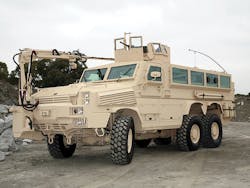Army chooses GMS rugged displays, embedded servers for mine-clearing vehicles
WARREN, Mich. - U.S. Army mine warfare experts needed rugged displays and embedded servers to help view and control sensor data on the Army's mine-clearing armored vehicles. They found their solution at General Micro Systems Inc. (GMS) in Rancho Cucamonga, Calif.
General Micro Systems is providing rugged displays and embedded servers for Army mine-clearing armored vehicles.
Officials of the Army Contracting Command in Warren, Mich., awarded a five-year, $88.6 million contract to GMS for four kinds of components for the multifunction video display (MVD) system on the Army Medium Mine Protection Vehicle (MMPV) Type II. The MMPV uses vehicle- mounted sensors to detect and classify potential explosive threats. Onboard vehicle sensors and systems that the MVD controls include the vehicle optical sensor system (VOSS), situational awareness cameras, man-transportable robotic system, interrogation arm, radios, and other communication systems.
GMS will provide 919 multifunctional video display kits, 305 auxiliary display kits, 57 brigade engineer battalion prescribed load list kits, 39 route clearance company kits, and 39 authorized stockage list kits. The GMS system has two chassis and two displays, and includes an enterprise-class rugged secure server with 12-port 1/10 Gigabit Ethernet switch, router, data storage, CITV/DVR, video over IP, and two thin, rugged smart-panel PCs. The ultra-small, rugged server uses the Intel Xeon E5 processor, and provides the armored vehicle with a distributed platform with smart displays that run the Army's MVD software.
The system's hardware and software distribute and control video in real time with low latency from all sensors mounted on the vehicle. Government-developed MVD software provides a seamless interface across several auxiliary subsystems. The system architecture is expandable to acquire digital data from more advanced sensors in the future. The MVD system selects and records still images and video streams securely to removable data storage.
The MVDs have connectors for alternate input devices like joysticks and keypads. The displays connect to a server switch exchange video and data, as well as interface to onboard removable data storage. The switch interfaces to onboard sensors through either a dedicated media converter or standard Ethernet.
For more information visit GMS online at www.gms4sbc.com.

